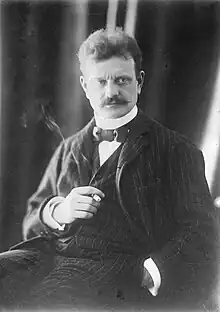| Valse triste | |
|---|---|
| Concert piece by Jean Sibelius | |
 The composer (c. 1902) | |
| Catalogue | JS 113/1 (original version) |
| Opus | 44/1 (revised version) |
| Composed | 1903, rev. 1904 |
| Publisher | Fazer & Westerlund (1901)[1][lower-alpha 1] |
| Duration | 6 mins. (orig. 5 mins.)[3] |
| Premiere | |
| Date | |
| Location | Helsinki, Grand Duchy of Finland |
| Conductor | Jean Sibelius |
| Performers | Helsinki Philharmonic Society |
Valse triste (literal English translation: Sad Waltz), Op. 44/1, is a short orchestral work by the Finnish composer Jean Sibelius. It was originally part of the incidental music he composed for his brother-in-law Arvid Järnefelt's 1903 play Kuolema (Death), but is far better known as a separate concert piece.
Sibelius wrote six pieces for the 2 December 1903 production of Kuolema. The first was titled Tempo di valse lente - Poco risoluto. In 1904 he revised the piece, which was performed in Helsinki on 25 April of that year as Valse triste. It was an instant hit with the public, took on a life of its own, and remains one of Sibelius's signature pieces.
Background
The background to the music as it functions within the original play is expanded upon by the programme notes for the production:
It is night. The son, who has been watching beside the bedside of his sick mother, has fallen asleep from sheer weariness, Gradually a ruddy light is diffused through the room: there is a sound of distant music: the glow and the music steal nearer until the strains of a valse melody float distantly to our ears. The sleeping mother awakens, rises from her bed and, in her long white garment, which takes the semblance of a ball dress, begins to move silently and slowly to and fro. She waves her hands and beckons in time to the music, as though she were summoning a crowd of invisible guests. And now they appear, these strange visionary couples, turning and gliding to an unearthly valse rhythm. The dying woman mingles with the dancers; she strives to make them look into her eyes, but the shadowy guests one and all avoid her glance. Then she seems to sink exhausted on her bed and the music breaks off. Presently she gathers all her strength and invokes the dance once more, with more energetic gestures than before. Back come the shadowy dancers, gyrating in a wild, mad rhythm. The weird gaiety reaches a climax; there is a knock at the door, which flies wide open; the mother utters a despairing cry; the spectral guests vanish; the music dies away. Death stands on the threshold.[5]
Publication and later developments
The original version, presented in 1903 as Tempo di valse lente - Poco risoluto, has not survived. Breitkopf & Härtel published the later piece in 1905 as 'Op. 44'. However, because of the nature of the publishing contract, Sibelius saw relatively little money in terms of royalties from performances of Valse triste. In 1906, Sibelius merged the third and fourth numbers of the incidental music into a single piece, which he renamed Scene with Cranes. This was posthumously published in 1973, as Op. 44, No. 2; Valse triste was retrospectively renumbered as Op. 44, No. 1.
According to the International Music Score Library Project in 2014, the work is "in the public domain in Canada (where IMSLP is hosted) and other countries where the term is life-plus-50 years (like China, Japan, Korea and many others worldwide). As this work was first published before 1923 or failed to meet notice or renewal requirements to secure statutory copyright, it is very likely to be public domain in the USA as well."[6]
Instrumentation
The score is written for Flute, Clarinet in A, two Horns in F, Timpani (unusually just a single one in D) and strings.
Notes
- ↑ On 20 July 1905, the Helsinki-based music publisher Fazer & Westerlund (Helsingfors Nya Musikhandel) sold its Sibelius holdings (the publishing rights and printing plates) to the German firm of Breitkopf & Härtel.[2]
References
- 1 2 Dahlström 2003, p. 201.
- ↑ Dahlström 2003, p. xxiv.
- ↑ Dahlström 2003, pp. 198, 201.
- ↑ Dahlström 2003, p. 200.
- ↑ "Valse Triste - Sibelius". Musicwithease.com. Retrieved Feb 5, 2015.
- ↑ "2 Pieces from Kuolema, Op.44 (Sibelius, Jean) - IMSLP/Petrucci Music Library: Free Public Domain Sheet Music". Imslp.org. Retrieved 2015-04-24.
- Dahlström, Fabian [in Swedish] (2003). Jean Sibelius: Thematisch-bibliographisches Verzeichnis seiner Werke [Jean Sibelius: A Thematic Bibliographic Index of His Works] (in German). Wiesbaden: Breitkopf & Härtel. ISBN 3-7651-0333-0.
Additional reading
- Kurki, Eija (2020). "A Play about Death, but the Music Lives On: Sibelius's Music for the Play Kuolema". SibeliusOne.com. Sibelius One. Retrieved 5 September 2023.
External links
- Valse triste: Scores at the International Music Score Library Project